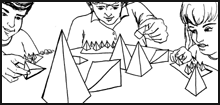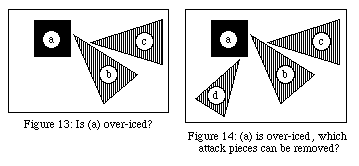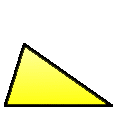 |
|
|
ICEHOUSE QUESTIONS & ANSWERS
 |
|
|
Below are some of the problems that many Icehouse players (both novice and advanced) come up against. The rules handle most of these situations, but you might have to dig and interpolate a bit for the solution. Some questions are included because they are frequently asked; others are here because they present such interesting situations, or have peculiar answers.
Q: When I capture a piece, may I play it immediately (without putting it on my stash pad first)?
A: Yes, the piece can be played immediately, even turned in place. But once you let go of it you may not touch it again, unless it still over-ices one of your own pieces.
Q: Can I point my attack piece at an attack piece? How about at its own color standing piece?
A: Not on purpose; not even if the piece you are placing is a captured enemy. If you did this by accident, your attack piece would have to stay where it is -- squandered. It is, however, quite all right to do this in a backward way; that is, block an attack piece by putting an attack piece (or a standing piece of the same color) in its line of attack. (See Figure 11.)

Q: If a player accidentally places his first several pieces in the attack position and no one calls "meltdown" until after the player has corrected it by placing two standing pieces, does a meltdown situation exist? Does the player have to return all of his attack pieces to his stash?
A: Technically, the meltdown is no longer valid after the two required standing pieces are on the field. However, if a player recognizes that he has not placed his two standing pieces, and no one has yet called "meltdown", he should not place standing pieces to compensate. The cool Icehouse player will call for a meltdown on himself, and return his attack pieces to his stash pad.
Q: Suppose I set out a defending piece but I don't let go of it, you know, I've got my finger on it and I'm trying to decide if I really want to play it where I've got it. What happens if someone sets out an attack piece and lets go of it while I'm still holding onto my defender? Can I take my defender back and leave his attack piece sitting out there, attacking nothing?
A: Yes, you can. If your opponent is dumb enough to let go of his piece while you've still got your finger on yours, he deserves what he gets. The attack piece is squandered, and stays where it is. Unless someone puts a defender in front of it, he'll get zero points for that piece.
Q: Could you please clarify the difference between a "Crash" and a "Jiggle?" My friend says that anything that moves the pieces is a crash, and he's always yelling crash for even the tiniest of changes, but I say it isn't a crash unless you really mess up. What do you say? Also, what do you do if you crash when you are attempting to remove a piece, like when you're capturing a prisoner? How about if you crash when you aren't doing anything with a piece at all, like if your elbow accidentally bumps something?
A: Let's think about the reasons behind the crash rule. The placement of pieces upon the playing field is not supposed to change during the game. If something disrupts the arrangement, you must pay a penalty.
Ok, so a "Crash" is a play that actually changes the arrangement of pieces on the field. You might do this if you are trying to squeeze a piece into a tight spot and the pieces around the spot move out slightly, enlarging the area, or you could bump a piece and it make it move to another position. If things really do change, you should give up the piece as a penalty.
A "Jiggle," however, is a crash that doesn't really change anything. If you bump a piece and it tips up but then falls back to the exact same position, then nothing has really changed and no penalty is needed. Here's another way of thinking about it: when a piece is played, the space it occupies is its "footprint." If it's a crash, then the piece's footprint will be different; if it's just a jiggle, the piece will have the same footprint.
The crash rule is not meant to penalize mere clumsiness, but to penalize actions that change the way pieces are positioned on the board, and therefore the inherent strategic situation. If nothing changes, no penalty should be paid.
Finally, remember that if you're just playing for fun in your own home, you should be a little more forgiving about crashes than you might be in a tournament or in a game where high stakes are being gambled.
If you crash while attempting to remove a piece, then you give away the piece you were trying to remove. If you crash when you aren't playing or capturing anything, you pay no penalty; just put things back the way they should have been.
Q: Suppose my standing piece is over-iced, and one of the pieces attacking it happens to be my own color. Can I capture my own attack piece? My standing piece would still be iced.(See Figure 12.)

A: No, you cannot capture your own attack piece. Even though your attack piece is pointing at a standing piece, it is not participating in the icing of anything. Removing it would be like removing any squandered attack piece on the board: illegal. Also remember that when scoring, this attack piece has a value of zero.
Q: I'm a bit confused about the role of squandered pieces in over-icing. In Figure 13, (c) is squandered. However, if (b) were removed, (c) would be icing (a). Does this mean that (a) is over-iced? (a) would still be iced if (b) were removed.
Also look at Figure 14. Now (a) is definitely over-iced. Can I remove (b), or is (d) the only piece that can be captured? Again, if (b) were removed, (a) would still be iced.

A: In Figure 13, (c) is squandered and is therefore not participating in an attack on anything. The standing piece is not over-iced, and nothing can be captured.
The situation in Figure 14 is similar, if slightly more complicated. The main point to remember in any potential over-ice situation is this: A piece is over-iced when the attack force is so redundant that one or more of the participating attack pieces are not needed to ice the standing piece.
Only pay attention to the participating attack pieces. In this particular case, ignore (c) completely. Now the situation is much easier to deal with. I will assume that (a) and (d) are worth 2 points each, and that (b) and (c) are worth 3 apiece. Now, (d) can be captured. However, (b) cannot be captured because the strength of (d) alone is not enough to ice (a). We are ignoring (c) because it is not participating, and therefore we cannot capture it.
There are sometimes ways for the defending player to get at those fat juicy (b) and (c) pieces, with a minimum of sacrifice. Let's look at the second picture again, and indulge ourselves in some imaginary play. It should be noted that if another attack piece (e) is pointed at (a), the standing piece will be over-iced enough to warrant capture of (b). (The other two attack pieces (d) and (e) now have enough strength to continue icing.) After (b) is captured, (c) is once again attacking (a) and is now a participant in over-icing. Players who are into tip blocking should be wary of this maneuver; a spare prisoner (or some diplomacy) and a little ingenuity can suddenly turn your enemy's stash pad into a prison camp.
Q: Suppose you get a prisoner before you've played your first two pieces. If you play the prisoner standing up, does it count as one of your two required defensive pieces?
A: No. Keep in mind that prisoners are not your pieces, but are merely under your control. Once you have played a prisoner, you have no claim to it at all; it belongs completely to the owner. Therefore, playing a prisoner defensively would only help your opponent meet his meltdown quota. Meanwhile, you are still accountable for having your own two defenders on the table.
This question brings up an interesting situation. Suppose you crash while trying to play your first piece. After giving it away, you decide to wait for a few seconds to see how the other players start off the game. What happens if the person who got your prisoner plays it defensively? More importantly, what happens if they use it for an attack?
As we've already seen, if they play it defensively they're just helping you meet your meltdown quota. You are then only required to play one more defensive piece. However, if they play it as an attack piece, then, well... you've had a meltdown. That's right! You've melted down without putting a single piece on the table. And guess what! You get to take your own piece back! As a player who has melted down, you must put all of your attack pieces back on your pad and then play your two required defenders.
Remember, the meltdown rule requires that two pieces of any given color be played defensively before any pieces of that color are used for attack. It is just as wrong for someone else to play an attack piece of your color before you've played your two defenders as it is for you to play such an attack piece yourself. So beware! If you find yourself with a prisoner very early in the game, be careful not use it as an attack piece until after the owner meets his meltdown quota.
Q: What happens if you set out a piece and it ends up resting partly ON TOP OF another piece, like if you're trying to block an attack with a prisoner and the prisoner winds up sitting on the tip of the attack piece?
A: All pieces played must sit completely on the playing field. Playing a piece so that it's sitting on another piece is illegal. Such a play, if it doesn't cause a crash, must be taken back. This is important to remember when two people are trying to place pieces at the same time in the same spot, as in the case of one player attempting to ice a piece while another player is attempting to block the attack with a defender. If the blocking player is too late, they'll be trying to place their piece on top of the tip of the attacking player's piece. Since this is an illegal play, the blocker would have to yield to the attacker.
Q: What happens if I successfully call Icehouse on someone who has a prisoner on his (or her) stash pad? Do I get the prisoner as well as the player's unplayed pieces?
A: Yes. Note, however, that the player gets to keep any prisoners that she (or he) gets later in the game, i.e. after the call has been resolved.
Q: Suppose I crash, but before I've actually given away the piece in my hand, someone calls Icehouse. Do I give the piece away before the Icehouse call is resolved, or do I put the piece back on my pad and give it away after we figure out if anyone is in the Icehouse?
A: You give it away first. As soon as it is recognized that you crashed, the piece in your hand no longer belongs to you, even if you take a moment to decide who gets it. If you have no un-iced defenders and that piece was your eighth piece, you are open to being put in the Icehouse, and the vultures you're playing with may not want to wait to find out who gets that piece before calling Icehouse.
This leads to an interesting strategic situation. If a crash and an Icehouse call occur simultaneously, and you are the one who crashed, but you aren't in danger of being put in the Icehouse, and there's a player with 7 stashed pieces and no un-iced defenders, then you might want to give that player the crashed piece. This would keep the poor player out of the icehouse and, more importantly for you, keep the person who called Icehouse (invalidly, at this point) from getting a whole squad of prisoners.
Q: Please clarify the rules regarding placement of illegal attacks. Suppose I'm trying to attack a piece in a hard-to-get-at area, and after I've done my best at positioning it and I've let go, the other players tell me that I'm actually pointing at a nearby defender of my own color. According to the rules, this is an illegal attack. Do I take it back, or leave it where it's played?
A: In this case, it stays where you put it, and it is squandered. Remember that, according to the rules, a piece cannot be moved once you've let go of it (unless it's over-iced). Since you believed you were making a legal play, the piece cannot be moved even if closer examination reveals that it wasn't a legal attack after all.
Your confusion probably stems from the fact that it also says in the rules that an illegally placed piece must be taken back. However, this line is primarily directed at new players, who often forget, during their first few games, that you cannot attack other attack pieces, or their own defenders. For a new player who hasn't quite learned all of the rules, an illegal attack should be taken back. But a skilled player who believes that he or she is making an acceptable attack must live with the consequences if it turns out to be an illegal play.
Q: Can I give another player a prisoner outright (i.e. can I just hand it to them)?
A: No. To give someone a prisoner, you need to do it via the mechanisms provided in the standard Icehouse rules, i.e. over-icing them, or giving a piece away as a penalty. This means that someone who wants a prisoner may need to sacrifice a piece by playing it defensively in order to leave room from someone to over-ice them. And don't forget that faking a crash in order to give someone a prisoner is extremely uncool.
There is one exception to this. In the variation called Casino Icehouse, prisoners can be directly bought and sold.
 |
 |
 |